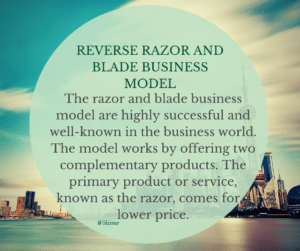The razor and blade business model is highly successful and well-known in the business world. The model works by offering two complementary products. The primary product or service, known as the razor, comes at a lower price.
The secondary product, known as the blade, comes with a higher profit margin. The razor product, although crucial, is not the primary source of income for the company.
Based on the razor and blade business model, many companies have developed some other business models. For example, the freemium business model comes from the razor and blade model, although not similar.
Another business model considered close to the razor and business model is its opposite, the reverse razor, and blade business model.

What are the Reverse Razor and Blade business model?
The reverse razor and blade business model, as the name suggests, is the opposite of the razor and blade model. In the reverse model, companies also sell two or more products that are complementary to each other.
However, companies make their primary earnings through the razor product rather than the blade product. Nonetheless, some companies may also charge respectable margins on their blade products.
The reverse razor and blade business model work best if a company offers a premium product or service that sells for a higher margin.
The customers must be willing to pay for the razor product or service to generate a profit. In most cases, the razor product or service doesn’t need the blade to function. Therefore, companies try to make profits from the product instead of relying on the blade product.
Similarly, the blade model in this business model only exists to sweeten the deal for the customers. While customers can use the razor product on its own, they can also benefit from using the blade product. Unlike the razor and blade model, the blade product in the reverse model is optional.
How do the Reverse Razor and Blade business model work?
As mentioned, the reverse razor and blade business model work for companies that have several products. A company using this business model sells a primary product, through which it earns a substantial amount of revenues.
The razor product offered by the company works on its own. Therefore, it does not need the blade product, unlike the razor and blade business model.
The blade product or services can be complementary. Similarly, a company may offer several blade products. In this model, the blade products or services do not complete the functionality of the razor product.
These products exist to provide customers with better options for using the razor product, although they are optional. However, unlike the original model, the blade product does not function on its own as well.
Unlike the razor and blade business model, the reverse variant may not charge a higher margin on blade products. On the contrary, the blade product may sometimes be free.
Therefore, the company does not put heavy reliance on the blade product. The blade products may come as features that enhance the razor product’s functionality, not lengthen it. For the company, the razor product will always be the priority.
What are the advantages and disadvantages of the Reverse Razor and Blade business model?
Although closely related to the razor and blade business model, its reverse variant does not share the same benefits and drawbacks. Some of the advantages and disadvantages of the reverse razor and blade business model are as below.
Advantages
The main advantage of using the reverse variant to the reverse razor and blade business model is that it allows companies to profit from the primary products rather than rely on secondary ones. This model also limits competition from others because other companies cannot sell the same product.
The customer also benefits from companies that use the reverse variant of the business model as they don’t need to pay for the blade products or services regularly. This model makes using the blade product optional.
Disadvantages
The reverse razor and blade business model may result in the company ending up developing blade products or services that won’t sell. As a company’s focus is its primary products, its blade products may not receive the same attention.
However, the company also faces the risk that customers won’t buy its razor products in the absence of blade products.
For customers, the disadvantage that comes from this model is the higher prices of razor products. These products may come with a premium price tag, unlike the razor and blade model. Therefore, affording the razor product may be an issue for some.
Examples
The best example of a company using the reverse razor and blade business model is Apple. The company sells its razor product, which includes laptops, phones, and tablets.
These products are the primary source of revenue for the company. However, it also sells blade products such as iTunes, AppStore apps, etc., which are secondary to its razor products.
Conclusion
The reverse razor and blade business model is a variant of the well-known razor and blade model. In this model, the company earns from the razor product rather than the blade product. The bladed product is optional in most cases for customers.